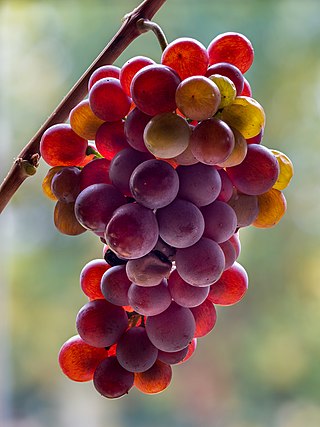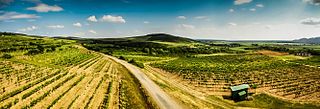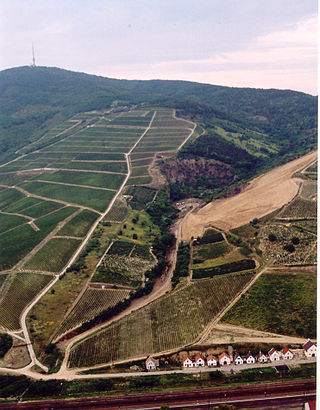
Sauvignon blanc is a green-skinned grape variety that originates from the city of Bordeaux in France. The grape most likely gets its name from the French words sauvage ("wild") and blanc ("white") due to its early origins as an indigenous grape in South West France. It is possibly a descendant of Savagnin. Sauvignon blanc is planted in many of the world's wine regions, producing a crisp, dry, and refreshing white varietal wine. The grape is also a component of the famous dessert wines from Sauternes and Barsac. Sauvignon blanc is widely cultivated in France, Chile, Romania, Canada, Australia, New Zealand, South Africa, Bulgaria, the states of Oregon, Washington, and California in the US. Some New World Sauvignon blancs, particularly from California, may also be called "Fumé Blanc", a marketing term coined by Robert Mondavi in reference to Pouilly-Fumé.

Tokaji or Tokay is the name of the wines from the Tokaj wine region in Hungary or the adjoining Tokaj wine region in Slovakia. This region is noted for its sweet wines made from grapes affected by noble rot, a style of wine which has a long history in this region. The "nectar" coming from the grapes of Tokaj is also mentioned in the national anthem of Hungary.

Pinot gris, Pinot grigio or Grauburgunder is a white wine grape variety of the species Vitis vinifera. Thought to be a mutant clone of the pinot noir variety, it normally has a pinkish-gray hue, accounting for its name, but the colors can vary from blue-gray to pinkish-brown. The word pinot could have been given to it because the grapes grow in small pinecone-shaped clusters. The wines produced from this grape also vary in color from a deep golden yellow to copper and even a light shade of pink, and it is one of the more popular grapes for skin-contact wine.

The Carménère grape is a wine grape variety originally planted in the Médoc region of Bordeaux, France, where it was used to produce deep red wines and occasionally used for blending purposes in the same manner as Petit Verdot.

Furmint is a white Hungarian wine grape variety that is most noted widely grown in the Tokaj-Hegyalja wine region where it is used to produce single-varietal dry wines as well as being the principal grape in the better known Tokaji dessert wines. It is also grown in the tiny Hungarian wine region of Somló. Furmint plays a similar role in the Slovakian wine region of Tokaj. It is also grown in Austria where it is known as Mosler. Smaller plantings are found in Slovenia where it is known as Šipon. The grape is also planted in Croatia & Serbia, where it is known as Moslavac. It is also found in Romania and in former republics of the Soviet Union. Furmint is a late ripening variety. For dry wines the harvest starts usually in September, however sweet wine specific harvest can start in the second half of October or even later, and is often affected by Botrytis.

Blaufränkisch is a dark-skinned variety of grape used for red wine. Blaufränkisch, which is a late-ripening variety, produces red wines which are typically rich in tannin and may exhibit a pronounced spicy character.

Tokaj wine region is a wine-growing region located in south-eastern Slovakia and north-eastern Hungary. The two vine-growing areas were once part of the greater Tokaj wine region of the Kingdom of Hungary. Following the Treaty of Trianon, a smaller part became part of Czechoslovakia, and after 1993, Slovakia. The majority of the region remained part of Hungary.
Hungarian wine has a history dating back to the Kingdom of Hungary. Outside Hungary, the best-known wines are the white dessert wine Tokaji aszú and the red wine Bull's Blood of Eger.

Tokaj wine region or Tokaj-Hegyalja wine region is a historical wine region located in northeastern Hungary and southeastern Slovakia. It is also one of the seven larger wine regions of Hungary. Hegyalja means "foothills" in Hungarian, and this was the original name of the region.

Marzemino is a red Italian wine grape variety that is primarily grown around Isera, south of Trentino. The wine is most noted for its mention in the opera Don Giovanni of Wolfgang Amadeus Mozart. The vine ripens late and is susceptible to many grape diseases including oidium. Wine produced from the grape has a characteristic dark tint and light plummy taste.

Friuli-Venezia Giulia wine is wine made in the northeastern Italian region of Friuli-Venezia Giulia. There are 11 denominazione di origine controllata (DOC) and 3 denominazione di origine controllata e garantita (DOCG) in the Friuli-Venezia Giulia area. The region has 3 indicazione geografica tipica (IGT) designations Alto Livenza, delle Venezie and Venezia Giulia. Nearly 62% of the wine produced in the region falls under a DOC designation. The area is known predominantly for its white wines, which are considered some of the best examples of Italian wine in that style. Along with the Veneto and Trentino-Alto Adige, the Friuli-Venezia Giulia forms the Tre Venezie wine region, which ranks with Tuscany and Piedmont as Italy's world class wine regions.
Schioppettino is a red Italian wine grape grown predominantly in the Friuli Venezia Giulia region of northeast Italy. The grape is believed to have originated between the comune of Prepotto and the Slovenian border, where records of the Schiopettino wine being used in marriage ceremonies date to 1282. The grape was nearly lost to extinction following the phylloxera epidemic of the late 19th century, when vineyard owners decided against replanting the variety in favor of French wine grapes like Cabernet franc, Cabernet Sauvignon, Pinot gris, Sauvignon blanc and Merlot. Some isolated plantings continued to exist until a 1978 European Union decree encouraged its planting in the province of Udine.
Ribolla Gialla is a white wine grape grown most prominently in the Friuli Venezia Giulia region of northeast Italy. The grape is also found in Slovenia, where it is known as Rebula. In Friuli Venezia Giulia, the grape thrives in the region around Corno di Rosazzo and Gorizia. In Slovenia, the grape is grown prominently in the Brda region. The grape is not related to the Friuli red wine grape Schioppettino, which is also known as Ribolla Nera. The obscure, lower quality Ribolla Verde grape is a mutated version that is not widely used.
Verduzzo is a white Italian wine grape grown predominantly in the Friuli-Venezia Giulia region of northeast Italy. It is also found in significant plantings in the Piave Denominazione di origine controllata (DOC) of the Veneto region, though some of these plantings may be of the separate Verduzzo Trevigiano variety. Verduzzo Friulano is used in varietal and blended wines, many of which fall under DOC as well as vino da tavola designations, that range in style from dry to late harvest wines. According to wine expert Oz Clarke, most of the sweeter examples of Verduzzo can be found in the Friuli-Venezia Giulia with the grape being used for progressively drier styles of the wine the further west into the Veneto.

Slovenia has more than 28,000 wineries making between 80 and 90 million litres annually from the country's 22,300 ha of vineyards. About 75% of the country's production is white wine. Almost all of the wine is consumed domestically with only 6.1 million L a year being exported—mostly to the United States, Bosnia and Herzegovina, Croatia, and lately the Czech Republic. Most of the country's wine production falls under the classification of premium (vrhunsko) wine with less than 30% classified as basic table wine (namizno vino). Slovenia has three principal wine regions: the Drava Wine-Growing Region, the Lower Sava Wine-Growing Region, and the Littoral Wine-Growing Region.

The Gorizia Hills is a hilly microregion in western Slovenia and northeastern Italy. It lies on the right bank of the Soča (Isonzo) River, north of the Italian town of Gorizia, after which it is named. The region covers around 120 km2 (46 sq mi) and has about 7,000 inhabitants, mostly ethnic Slovenes, with a small number of Friulian speakers in its westernmost part.
The Colli Orientali del Friuli is a Denominazione di origine controllata (DOC) located in the Italian wine region of Friuli Venezia Giulia. The region is located in the province of Udine and is sub-divided into three main sections; Ramandolo in the north, Cialla and Corno di Rosazzo. The climate and soil is very similar to the neighboring DOC of Collio Goriziano and the two region share many winemaking similarities as well. The main distinction between the Colli Orientali del Friuli and Collio Goriziano lie in the increased red and dessert wine production of the Colli Orientali del Friuli. The region also includes within its boundaries the three Denominazione di origine controllata e garantita (DOCG) of the Friuli Venezia Giulia Ramandolo and the two passito wine DOCGs of Colli Orientali del Friuli Picolit and Colli Orientali del Friuli Picolit-Cialla.
Collio Goriziano is an Italian wine and winemaking region in northeast Italian region of Friuli Venezia Giulia, located in the northernmost part of the Province of Gorizia, in the Italian part of the Gorizia Hills, which extend to neighboring Slovenia. It has been recognized with the official the status of DOC. Colli Goriziano predominantly produces white wines with Friulano, Ribolla Gialla, Malvasia Istriana, Chardonnay, Pinot bianco, Pinot grigio, and Sauvignon blanc being the leading varietals. Red wine is also produced under the Collio Rosso designation and is usually a blend of Merlot, Cabernet Franc, and Cabernet Sauvignon.

Baratuciat is a white Italian wine grape variety that is grown in the Piedmont wine region of northwest Italy. For most of its history, Baratuciat was used mainly as a table grape with some limited use for wine production with sweet late-harvest dessert wines. On 23 June 2008 the grape was officially added to the Italian registry of wine grape varieties.













